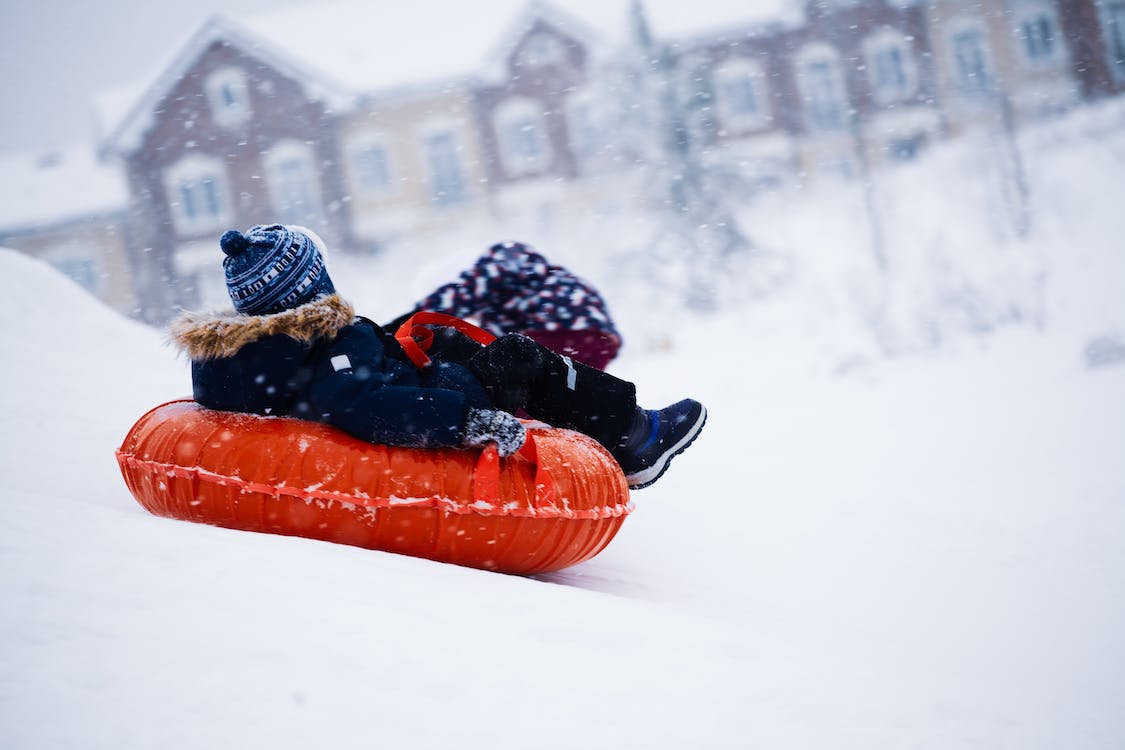Get on top of a snowy hill. Ride an inflatable inner tube. Slide and have fun!
That’s basically what snow tubing is about. Once considered as an outdoor winter activity, it can now be done all-season on a typical backyard hill – thanks to snowmaking technologies. However, it’s obviously more enjoyable to do during winter with real snow.
Snow tubing explained
Snow tubing is simply a fun, recreational activity that makes use of gravity to transport oneself to the bottom of a slope while riding an inner tube. A steeper run equals higher speed.
There is no skill required to be able to snow tube. There is no training required, no practice needed and no muscle strength necessary. As long as you can sit and hold on, you are good to go.
Snow tubing can be likened to going down a straight water slide in a tube. To keep the tube sliding in one direction, snow is often built up along each side of a predetermined lane. At the long run out down the hill, riders will be brought to a stop.
This activity is somewhat similar to sledding, but the difference is, you have a softer surface to sit on. With a sled, you can drag your arms in the snow to break; but if you do this with a tube, you may just spin downhill because it would be difficult to control its direction.
Keeping safe
To ensure safety, you must check out any location first before deciding to ride your tube and slide down. Really make sure that there would be a long run out at the bottom for stopping, and keep away from dangerous barriers like boulders and trees.
If you’re on for adrenaline-charged experiences, it may be tempting to perform big jumps on the round snow tubes. But as we said above, the tube is extremely hard to control, so attempts to perform tricks might lead to a severe injury. When the going gets too tough and rough, your best bet would be to bail off the tube by rolling or hopping off the ground. For security purposes, wear a helmet at all times.
There are several places where you can enjoy snow tubing while ensuring safety. Ski resort areas have long been offering snow tubing as one of the many other fun-filled activities they offer besides skiing. They designate special snow tubing areas with slopes and barriers to keep snow tubers on a safe course. Indoor and outdoor tubing parks were also built with specific lanes designated for tube rides. Safe racing is encouraged by putting a single lane for every person.
Snow tubing equipment
Some snow tubers use inner tubes of regular car or truck tires. Although these and other inner tubes can be functional for snow tubing, there are specifically designed snow tubes available in the market that are safer, can easily glide across snow and can endure low temperatures. Most snow tubes have a donut hole. Some tubes have solid, dimpled center to prevent the tuber from being dragged through the snow.
Most snow tubes are made of a heavier gauge material to help prevent damages due to sticks and rocks that may be sticking out of the snow. Some have strong materials that have superior cold crack resistance. Some may also feature a bottom layer that is meant to keep the rider dry. Plus, there are tubes that are designed with rugged handles, while there are some without it.
When snow tubing in winter, you need to consider wearing warm, water-resistant clothes and shoes. Use gloves and scarves or any other accessories you would wear on a snowy day. And please don’t forget your helmet or any protective headgear just in case you need to tumble away from your snow tube while it’s speeding.
History
While we might never know who was the first person who came up with the idea of riding a tube down a snow-covered slope, we know that it was practiced around the 1800s. It was rumored to have started in Canada when Prime Minister Sir Robert Borden allowed the Members of the Parliament to take a day off and slide around Parliament Hill during a snowstorm in Ottawa. It became a popular choice for backyard entertainment, second to the traditional toboggan sledding, and was practiced over the next hundred years since.
Inner tube from tires was usually used as a snow tube back then. It started when John Boyd Dunlop invented the first air-filled tires in the 1880s to be used for his son’s tricycle. These tires were too heavy to slide. Around the 1980s and early 1900, many patent applications for the use of an inner tube have been filed.
Its first use as a snow tube was just a mere speculation. Probably, someone from an inner tube factory at the top of a hill must have tripped on one and found himself sliding to the bottom of the hill. When the practical tire with an inner tube was launched in the market, the hills were probably being enjoyed by the first tubers.
Modern snow tubing came in about the late 1990s when mainstream ski resorts began seeing the potential of this fun and exciting activity. Ski resort owners began turning the unused property into money-making tubing lanes. Snow tubing was brought by enthusiasts to the mountains. After two decades, snow tubing produced its own professionals who gained enough popularity for the sport to be considered in the 2010 Olympics in Vancouver, Canada. However, it didn’t make it.
As snow tubing continues to become popular, more and more ski areas are offering tube parks. Some are even offering snow tubing late into the summer, like Adventure Point at Keystone Resort and Steamboat Springs, both in Colorado.
Snow tubing is one of the fastest growing winter activities in America, considering it’s the growing sales of snow tube products. Surely, its history is still unfinished and would have a long way to go.

